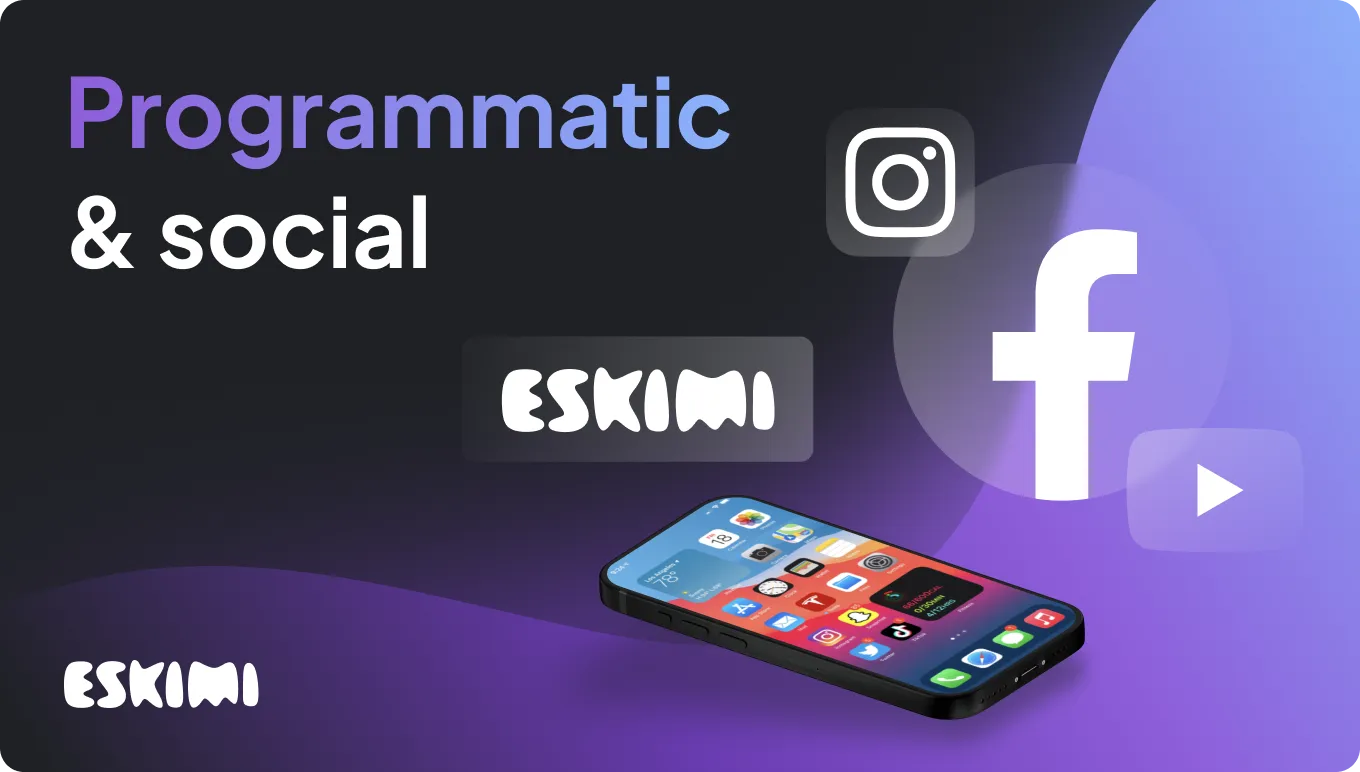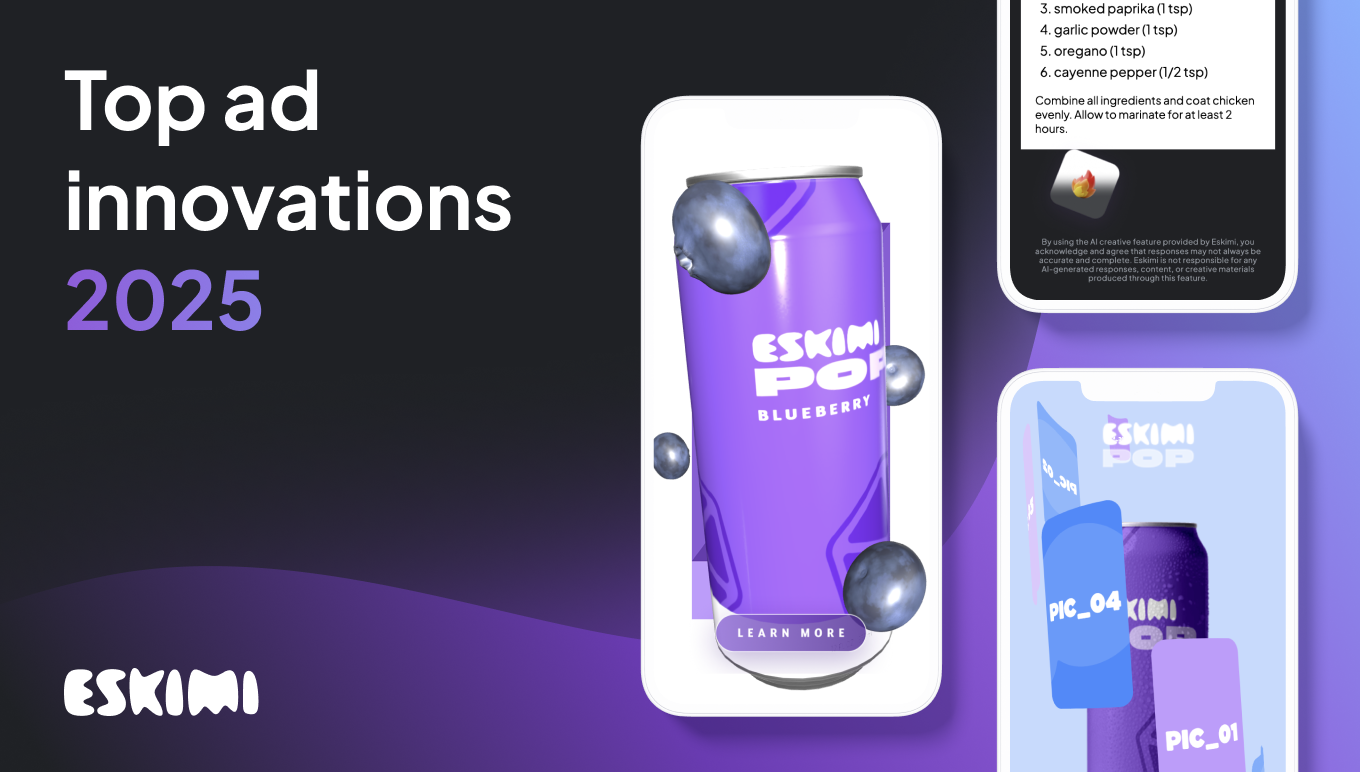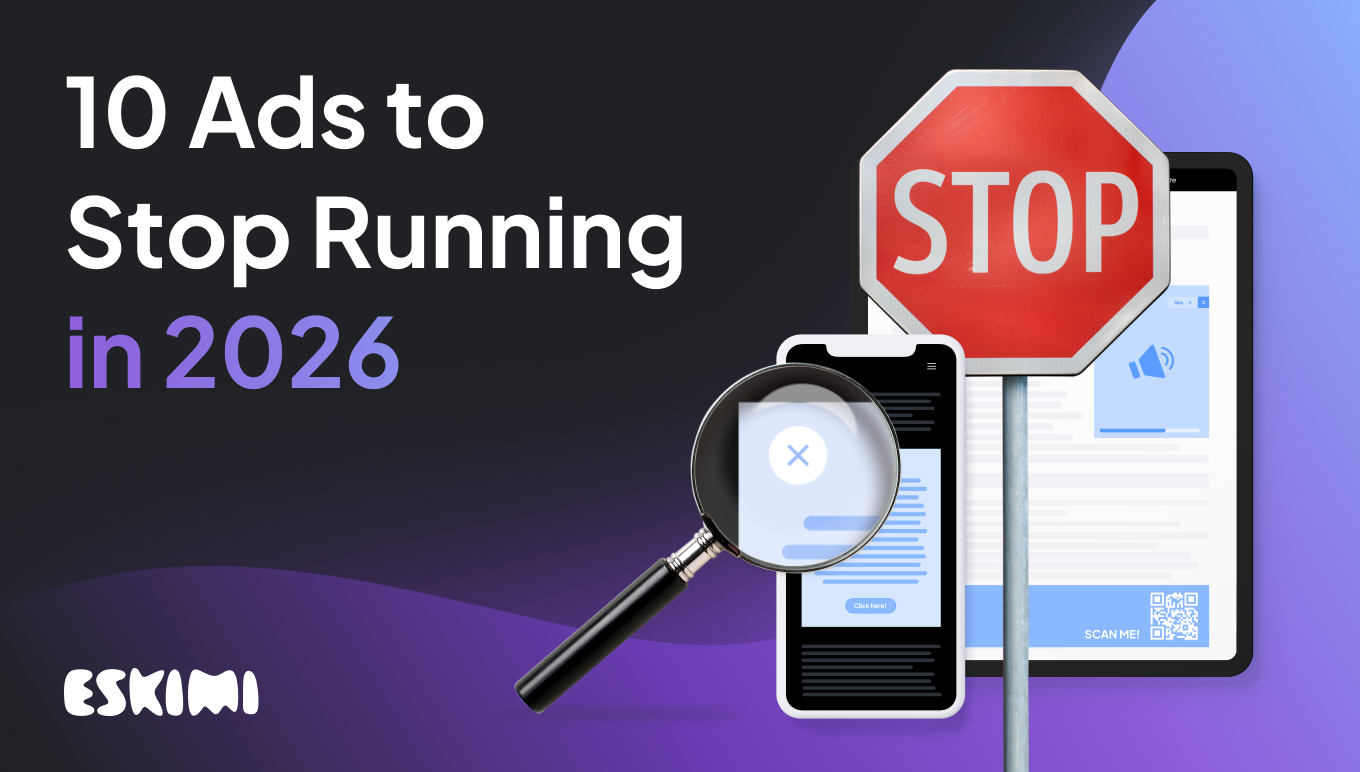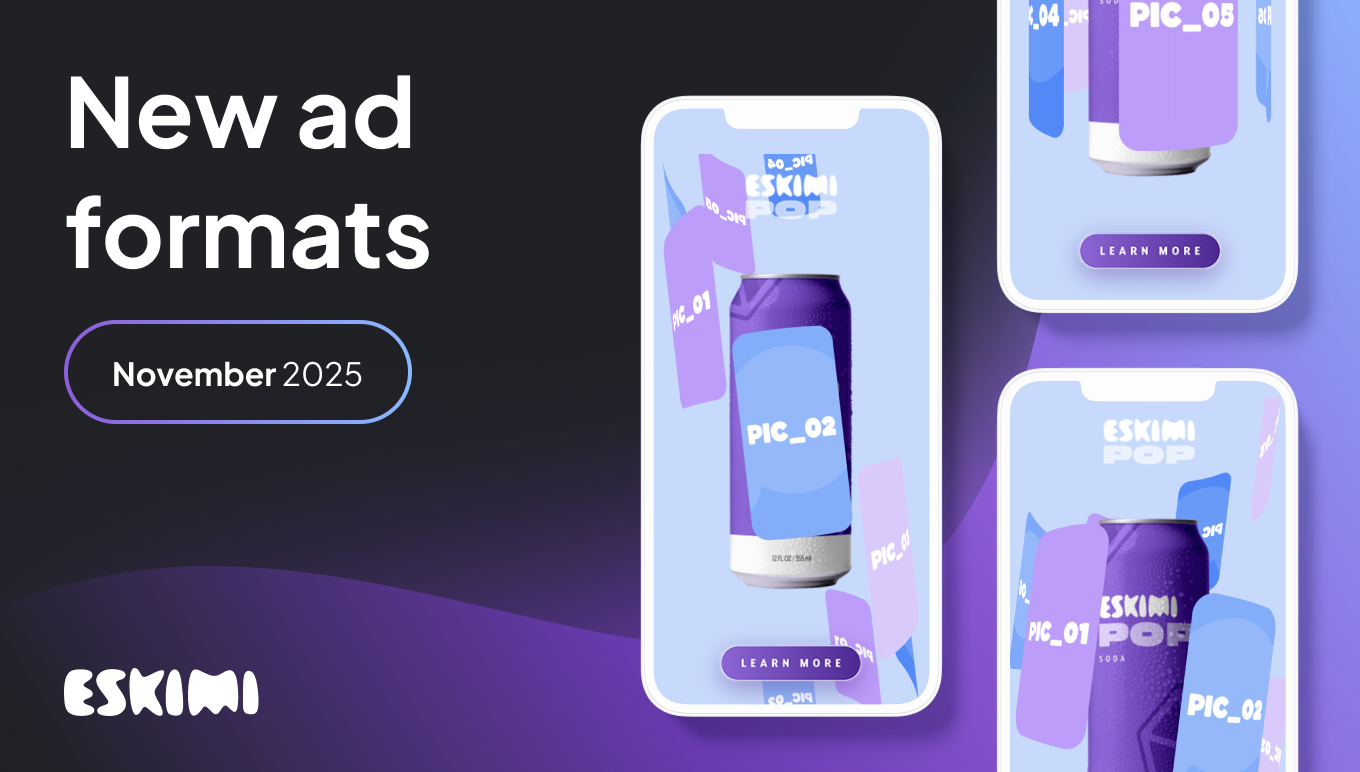Social and programmatic advertising: How they work together

Many consumers have shifted to digital, and the brands had no choice but to follow.
With this shift, the competition online jumped to new heights, forcing companies to rethink their marketing strategies and allocate more budgets to growing their digital presence.
Advertising is one of the best ways to do it, offering brands a variety of channels, including social media and programmatic advertising, that can help to stay at the top of consumers' minds.
The good news is that you don't have to choose one or the other.
Instead of pitting social media advertising against programmatic advertising or vice versa, you can learn how the two can work together to create a powerful marketing mix.
This is what we'll go through in this post comparing four big players in the online advertising industry – Facebook, Instagram, YouTube, and Eskimi, and learning how they can complement each other.
Let's start with the basics
It's common for brands to rely mostly on social media advertising as it's one of the fastest ways to reach a potential customer. However, programmatic advertising is quickly gaining pace as a cost-effective solution that can help reach diverse audiences in different environments.
Each advertising platform has its own specifics and advantages that make it an attractive option for advertisers.
For instance:
- Facebook: As of the beginning of 2025, Facebook has over 3.7 billion monthly active users, and that's a huge potential audience. Advertising accounts for the vast majority of the social network's revenue ($160,633M in 2024) as it offers a range of options, including display ads, video ads, and sponsored posts.
- Instagram: Although part of Meta, Instagram is a slightly different advertising space. It's focused on on photo and video sharing, so image and video ads fit the tone better. At the time of writing, it has more than 1.44 billion users worldwide and allows advertisers to serve sponsored posts, stories, and reels.
- YouTube: It's probably not wrong to call YouTube a king of video advertising as it's one of the most popular video content platforms with over 2.5 billion active users. Therefore, its advertising inventory doesn't vary that much but is well-suited for those who want to promote their products or services using display, overlay, and video ads.
- Eskimi: Eskimi is a full-stack programmatic advertising platform capable of reaching 1.5B+ people worldwide. Using programmatic advertising, advertisers are not limited by specific platform's boundaries (in this case, social platforms) but can serve their digital ads on different advertising channels globally, including in-game, CTV, not to mention “traditional” ads like display and video.
Although very similar, these platforms also have different capabilities that can slightly impact advertising possibilities and efforts in one way or another.
Let's fill in the gaps and see how social media and programmatic advertising can create a unified advertising solution and boost overall advertising efforts.
The customizability of deals
If you've ever launched ads on Facebook, Instagram, or YouTube, you know that the process is pretty straightforward. There's one way to do it – directly – and your ads will appear within the platform's boundaries, i.e., in users' Facebook feeds, Instagram stories, etc.
In programmatic advertising (Eskimi, in this case), there are several different programmatic ad buying options, including:
- Open auction – bidding strategy where advertisers bid on ad inventory in real-time, and the highest bid wins the slot.
- Private auction – publishers make their premium inventory available for invited advertisers who bid on a particular ad space.
- Direct deals include programmatic guaranteed and preferred deals, where advertisers agree with publishers directly to purchase ad inventory – fixed price for specific digital ad inventory.
Selection of ad formats
Moreover, social media and programmatic differ a lot in terms of ad types available.
While social media platforms kind of force you to fit into their specific requirement frames, with programmatic, you can serve a wider variety of ad formats and customize them as you wish.
.avif)
Each ad type can help you fulfill different goals and objectives, so think of those carefully before planning an ad campaign.
Try to find an answer to the question of which of them can help you deliver your message so it's clear, engaging, and convincing.
Advanced high-impact ads
Talking about ad types, the appearance and interactivity of ads are one of the most significant differences between social media and programmatic advertising.
While the variety of formats varies a lot for both channels, the difference lies in the level of engagement these programmatic ads can offer.
In terms of interaction, social media ads enable advertisers to run polls (Meta), check different offers in carousels by simply swiping through content, and give users a taste of a product using AR technology, among other features.
Programmatic ads throw in an ace with rich media and high-impact possibilities – ads that can capture user attention and leave a long-lasting impression.
Using rich media allows your target audience to interact with the ad, changing its content through actions such as clicking, swiping, or even blowing into the microphone to reveal the offer.
High-impact ads, on the other hand, enable high viewability and attention by design.

For example, screen takeover ads expand after users click on them and, you guessed it, take over the screen, allowing the audience to learn more about the offer, e.g., by watching a video.
Put simply, it takes engagement to another level, leaving simple clicking behind and bringing new opportunities for brands to keep their audiences interested.
Walled gardens vs. open internet
A walled garden refers to a closed advertising ecosystem created by a large company that is operated without the involvement of outside people and organizations. Or in other words, the ecosystem where publishers own the entire advertising process.
In this case, Meta is what we would call a walled garden, while Eskimi falls under the definition of the open internet.
Walled gardens, as well as the open internet, have their advantages and disadvantages, some of which are:
- Walled gardens create a one-stop shop for advertisers, but they come with a high level of control. Within the open internet, everyone can access and publish content without facing such a challenging environment.
- Walled gardens offer a variety of ad formats, yet they're mostly traditional image and video-related types. Programmatic advertising enables creativity to flourish, as it allows you to utilize both traditional and high-impact ads that are interactive and innovative.
- Both walled gardens and the open internet offer a broad reach to diverse audiences. The difference is that platforms like Facebook, Instagram, and YouTube enable you to reach a global audience within their boundaries, while Eskimi (and programmatic advertising in general) enables advertising on global websites and apps (within their ad inventory).
- Advertising within walled gardens is mostly self-service, which can be both an advantage and a limitation, depending on your situation and needs. Self-service often means limited support is available, but you can do everything yourself. Programmatic advertising companies, on the other hand, typically offer both self-service and managed service options, making it easier to get help and guidance.

All things considered, whether you use only a walled garden or a programmatic advertising platform, you can still reach your goals.
However, finding the right balance between each channel's strengths and limitations and leveraging a combination of multiple channels might be the best solution to reach relevant audiences.
Advanced targeting capabilities
Both social media networks and programmatic advertising give you a range of options to reach your target audience.
Targeting on social media is primarily based on demographic and behavioral data (age, gender, location, occupation, life events, event attendance, etc.). You can also target specific audiences with customized lists that you create yourself.
Programmatic targeting revolves around similar data points plus a couple of extras, like telco and contextual, also allowing one to go deeper into each and use options like socio-economic or daypart targeting.
Of course, if you use only social media or only programmatic advertising, you will be limited to specific channel boundaries for a specific target audience, e.g., people who use Meta's services or audiences available in the programmatic inventory.
It's essential to consider that each of these channels provides distinct options, allowing you to leverage a broader range of solutions to target specific audiences by advertising on multiple platforms.

Dynamic triggering
Dynamic triggering refers to the practice of creating and displaying ads that are customized in real-time based on the user's behavior, interests, events, weather, and other factors (these can vary depending on the channel). Using this approach, advertisers can serve more personalized, highly targeted ads that can improve the campaign's effectiveness.
Although both programmatic and social media have the option to apply dynamic triggering, it's based on different parameters. Therefore, ads differ in their purpose and function.
For instance, Meta allows showing dynamic ads based on users' interests and past behavior, such as previous purchases, page views, or interactions with the brand's website or app. So, if a user checks a red dress on an online store, they might see a dynamic ad featuring that same red dress, along with other items related to their browsing history.
Meanwhile, in Eskimi, dynamic ads work via API integrations that help keep content relevant in real-time, enabling ads for weather-related content, live scores, or product feeds.

The key difference between the two channels is that while social media's dynamic ads are based on the user's actions, programmatic dynamic triggering is based on available data, e.g., real-time weather conditions.
Brand safety
Brand safety is crucial to advertising, regardless of the channel and platform you use.
It refers to the measures taken by both advertisers and publishers to ensure that ads do not appear in contexts that are harmful, offensive, or inappropriate, which could damage a brand's reputation.
Any platform you're using or about to use for advertising has brand safety measures in place that can help you avoid putting your brand on blast.
So, programmatic ads or social media platforms?
Every channel has unique strengths and weaknesses, and for advertisers, it's crucial to identify and consider those before deciding on programmatic or social media marketing.
While social media can provide an effective way to reach specific audiences within its boundaries, programmatic advertising can offer a more efficient and automated process to buy ad inventory across various publishers in general.
In some cases, one platform's advantage can also be a disadvantage compared to another, for example, when you have lower Facebook CPMs, you lose the creative possibilities of programmatic advertising.
Ultimately, the choice between social media and programmatic advertising depends on your specific goals, budget, target audience, and other relevant factors. A smart advertising strategy could incorporate both approaches, taking the best from both worlds, to maximize the effectiveness of your efforts.
Level Up Your Advertising with Eskimi
- Reach 96% of Open Web
- 2,500+ Targeting Options
- 100% Managed or Self-Service
- In-House Creative Studio Team
- Display, Video, In-Game & CTV
- #1 Rated DSP on G2





